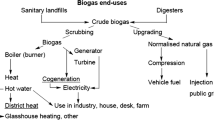Abstract
Coal-based power plants are largest emitter of CO2 as a single sector. To use fossil fuels (including coal), CO2 capture and storage is a visible option. But large energy requirement for this process and risk associated with storage of CO2 demand alternative solutions including recycling of captured CO2. In this paper, a co-production of power and urea is proposed using coal with captured CO2. Detailed ASPEN Plus® model is developed for this plant. As shift reaction for producing H2 has significant effect on output parameters, analysis is done for two different values of shift reaction, i.e., 90 and 95 % conversion. Plant consumes substantial auxiliary power (~19 % for the base case). Auxiliary power becomes a minimum for about 25 % captured CO2 utilization for 95 % shift conversion. An economy factor is also defined to estimate the economic advantage of utilizing captured CO2. Results show that economic advantage is obtained for CO2 utilization beyond ~5 % for 95 % water gas shift reaction and it is beyond ~10 % for a 90 % shift reaction.









Similar content being viewed by others
References
Austin GT (1984) Shreve’s chemical process industries, 5th edn. McGraw-Hill, USA
Benjamin MFD, Tan RR, Razon LF (2014) A methodology for criticality analysis in integrated energy systems. Clean Technol Environ Policy. doi:10.1007/s10098-014-0846-0
Cornelissen S, Koper M, Deng YY (2012) The role of bioenergy in a fully sustainable global energy system. Biomass Bioenergy 41:21–33
Hetland J (2009) Assessment of pre combustion decarbonization schemes for polygeneration from fossil fuels. Clean Technol Environ Policy 11:37–48
IEA (2011) International Energy Agency. World Energy Outlook, Paris
IPCC (2013) IPCC fifth assessment report. Climate change (AR5). www.ipcc.ch/ Accessed date 09 Jun 2014
Jana K, De S (2014) Polygeneration performance assessments: multi-dimensional viewpoint. Clean Technol Environ Policy. doi:10.1007/s10098-014-0885-6
Jana K, De S (2015a) Polygeneration using agricultural waste: thermodynamic and economic feasibility study. Renewable Energy 74:648–660
Jana K, De S (2015b) Techno-economic evaluation of a polygeneration—a case study for an Indian district. Bioresour Technol 181:163–173
Klemes JJ, Varbanov PS (2013) Process intensification and integration: an assessment. Clean Technol Environ Policy 15:417–422
Louisiana Ammonia Plant (2013) presentation 17 April. Inctec Pivot Limited, Dyno Nobel, Inctec Pivot Fertilisers. phx.corporate-ir.net/External.File?item = UGFyZW50SUQ9MTgwNDQwfENoaWxkSUQ9LTF8VHlwZT0z&t = 1. Accessed date 09 Jun 2014
Ng KS, Zhang N, Sadhukhan J (2012) Decarbonised coal energy system advancement through CO2 utilisation and polygeneration. Clean Technol Environ Policy 14:443–451
Ng KS, Zhang N, Sadhukhan J (2013) Techno-economic analysis of polygeneration systems with carbon capture and storage and CO2 reuse. Chem Eng J 219:96–108
Nordbotten JM, Kavetski D, Celia MA, Bachu S (2009) Model for CO2 leakage including multiple geological layers and multiple leaky wells. Environ Sci Technol 43(3):743–749
Open EI (2014) Transparent cost database. http://en.openei.org/apps/TCDB/ Accessed date 09 Jun 2014
Rusinak D, Alabi S, Arana J, Moscoso E, Yazvin O (2014) Production of Prilled Urea. http://teamecho.wikispaces.com Accessed date 09 Jun 2014
Spliethoff H (2010) Power generation from solid fuels. Springer, Berlin
ZEP (2011) The Costs of CO2 capture, transport and storage: post-demonstration CCS in the EU European energy technology platform for zero emission fossil fuel power plants. Zero emissions platform. www.zeroemissionsplatform.eu/. Accessed date 09 Jun 2014
Zhang X, Gundersen T, Roussanaly S, Brunsvold AL, Zhang S (2013) Carbon chain analysis on a coal IGCC—CCS system with flexible multi-products. Fuel Process Technol 108:146–153
Acknowledgments
Kuntal Jana acknowledges to Council of Scientific and Industrial Research (CSIR-New Delhi, India) for awarding Senior Research Fellowship for this research toward PhD.
Author information
Authors and Affiliations
Corresponding author
Rights and permissions
About this article
Cite this article
Bose, A., Jana, K., Mitra, D. et al. Co-production of power and urea from coal with CO2 capture: performance assessment. Clean Techn Environ Policy 17, 1271–1280 (2015). https://doi.org/10.1007/s10098-015-0960-7
Received:
Accepted:
Published:
Issue Date:
DOI: https://doi.org/10.1007/s10098-015-0960-7




